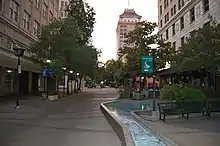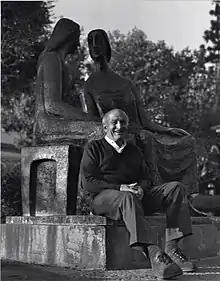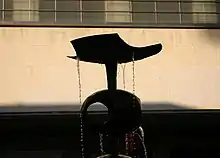 Fulton Mall between Kern and Tulare Streets in 2011, before reintroduction of traffic | |
| Type | Pedestrian Mall |
|---|---|
| Location | Fresno, California |
| Coordinates | 36°44′05″N 119°47′28″W / 36.7348°N 119.7912°W |
| Construction | |
| Construction start | March 31, 1964 |
| Completion | September 1, 1964 |
| Demolished | March 3, 2016 |
| Other | |
| Designer | Garrett Eckbo as part of EDAW |
| Known for | Modernist landscape design |
The Fulton Mall was a six-block corridor in downtown Fresno, California which was closed to traffic in 1964 and made into a pedestrians only mall. Despite opening to much fanfare, the downtown mall suffered from the city's suburban expansion, especially the opening of the Fashion Fair Mall six miles to the north. By the 1980s, most storefronts on the mall were empty and plans to renovate the mall were discussed. In 2017, car traffic was reintroduced to the street after most of the public art and amenities had been relocated to sidewalk areas.[1]
The mall was an early example of the design intent and masterplan-oriented thought process of shopping mall pioneer Victor Gruen, whose ideas were emulated, albeit in a modified form, across the United States. The mall is also an example of noted landscape architect Garrett Eckbo's modernist landscape design ethos.
History
Pedestrian mall
Fulton Street, originally J Street, has been a main corridor for business activity for Fresno since the city's inception.[2] It sits a block over from the Central Pacific Railroad Station, the primary way early visitors came to Fresno. J Street was renamed "Fulton" in honor of prominent local financier Fulton G. Berry after his death in 1910.
Several notable buildings were constructed on Fulton Street, including the 10-story Helm Building in 1914, which was called Fresno's first skyscraper. Locally-founded Gottschalks moved into a large retail space on Fulton Street in 1914. The 8-story Bank of Italy building followed in 1918 as well as the Rustigian Building on the south end of Fulton Street, completed in 1920. Adding to the retail activity in the area, the Radin-Kamp Department Store opened on Fulton Street in 1924. The historic San Joaquin Light and Power Corporation Building and the Warnors Theater sit on the north end of Fulton Street, both built in the 1920s.
Fresno experienced a population boom after World War II, reaching 100,000 in 1958.[2] Much of the growth pushed northward, with Fresno State relocating in 1956.[2] Retail centers opened to the north in the late 1950s as well, such as Manchester Center and Fig Garden Village. To revitalize downtown, the Arthur L. Selland-led city of Fresno hired pioneering Austrian architect Victor Gruen who had attempted similar revitalization projects in Kalamazoo, Michigan and Fort Worth, Texas.[2]
Under Gruen's supervision, Fulton street was transformed into a pedestrian-only space named Fulton Mall. The project was designed by American landscape architect Garrett Eckbo, as part of his EDAW landscape architecture design firm.[3] The mall was dedicated on September 1, 1964, to much fanfare. The mall contained major retailers such as Gottschalks, Montgomery Ward, Woolworth, and JCPenney.[4][5]
The mall was designed as a social space, a focus of community interest and events, a promenade and rendezvous with friends, a play area for children, and a meeting place for teenagers.
The opening of Fashion Fair Mall in 1970 indicated that the Fresno's northward sprawl was not abating.[6] The Fulton Mall declined, with one notable example occurring in 1988 when Gottschalks, an anchor since 1914, moved from the mall to the Woodward Park area.
Fresno poet Gary Soto memorialized the street scene of Fulton Mall in a 2001 poem.[7]
Reintroducing traffic
In 2002, a city redevelopment agency presented a plan to the city council proposing to return auto traffic to the Fulton Mall. The move was opposed by a group of citizens called the Downtown Fresno Coalition. In 2006, the city council called for another study of the Fulton Mall so that a decision could be made but the standoff only intensified.[2][8]
In 2008, the preservationist citizens group prepared a nomination of the Fulton Mall to the National Register of Historic Places (NRHP) in an effort to block or complicate the reintroduction of cars. The mall was deemed eligible for the NRHP but was not listed due to objections from the city administration and a majority of the property owners.[2]
Mayor Ashley Swearengin commissioned a plan which included three options for renovating the mall. Two of the options returned car traffic with varying degrees of preservation of the existing mall features and amenities. The third option kept the mall pedestrian free.[2]
In September 2013, the City of Fresno received a $15.9 million TIGER Grant from the US Department of Transportation to reintroduce traffic to Fulton. On February 27, 2014, the Fresno City Council decided the fate of Fulton Mall with a 5–2 vote in favor of putting traffic back on Fulton street while preserving as much of the character of the original design as possible.[9][10]
A groundbreaking ceremony was held on March 3, 2016.[11] The $20 million project was completed in October 2017 and the reopening was attended by mayor Lee Brand, former mayor Swearengin, representative Jim Costa and others.[12]
Notable features
Public Art
Money was raised from private donors to buy or commission public art and install it on the mall.[13][14]





- The Visit by Clement Renzi.[15]
- Rite of the Crane by Bruno Groth, a 6 feet (1.8 m) high bronze sculpture.[15]
- Talos by James Lee Hansen, a predecessor to Talos No. 2 in Portland, Oregon.[15]
- Aquarius Ovoid by George Tsutakawa, a brass sculpture.[16]
- Trisem by T. Newton Russell, an installation of three columns of granite boulders, approximately 12 feet (3.7 m) high, set inside of a pool water feature.[2]
- Dancing Waters by Stan Bitters.[15]
- Valley Landing by Gordon Newell, a sculpture made of black granite from a local quarry.[2]
- La Grand Laveuse (Washer Woman) by Pierre Auguste Renoir.[15]
- A concrete platform commemorating the location where the Industrial Workers of the World fought for the right of free speech in their efforts to organize labor in Fresno. It is registered on the list of California Historical Landmarks as number 873.[15]
- Clock Tower by Jan de Swart, an approximately 60 feet (18 m) high installation made of wood and fiberglass. It includes four clocks at the top which face in each direction.[15]
- Big A by Peter Voulkos, a sculpture consisting of aluminum pillars and cross plates with bronze ovals on the plates.[15]
- Arbre Echelle by Brancois Stahly, an approximately 10 feet (3.0 m) high bronze sculpture.[15]
- Orion by Bernard Rosenthal.[15]
- Mother & Child by Romondo Puccinelli, a porpyry sculpture approximately 2.5 feet (0.76 m) high, on an approximately 3 feet (0.91 m) high base of locally sourced granite.[15]
- Ellipsoid VI by Charles Owen Perry, an approximately 4 feet (1.2 m) high bronze plate sculpture located in the middle of a pool water feature.[15]
- Smoldering Fires by Claire Falkenstein.[15]
- Yokuts Native American by Clement Renzi, a cast bronze sculpture representing a member of the Yokuts tribe standing with his arms stretched upward to greet the rising run.[15]
- Obos by George Tsutakawa, an approximately 10 feet (3.0 m) high bronze sculpture fountain. Obos are said to represent stacked stones found in the Himalayas.[16]
Most mall features were relocated from the middle of the mall to the sidewalk areas in 2016, making way for vehicular traffic. There were moved to approximately following locations:
| Mural District | |
| Fulton Street | |
| Stanislaus St. | Stanislaus St. |
| PG&E Building | Warnors Theater |
| Tuolumne St. | Tuolumne St. |
| The Visit | |
| Talos | Rite of the Crane |
| Merced St. | Merced St. |
| Brix Building | Trisem |
| Aquarius Ovoid | |
| Fresno St. | Fresno St. |
| Guarantee Savings Building | Valley Landing |
| Helm Building | La Grande Laveuse |
| Big A | |
| Mariposa St. | Mariposa St. |
| Clock Tower | Pacific Southwest Building |
| Mariposa Plaza | Arbre Echelle |
| Mason Building | |
| Tulare St. | Tulare St. |
| T. W. Patterson Building | |
| Orion | Mother & Child |
| Ellipsoid VI | |
| Dancing Waters Smoldering Fires |
Kern St. |
| Old Gottschalks Building | |
| Obos | |
| Yokuts Native American | |
| Spiral Garage | |
| Inyo St. | Inyo St. |
| Brewery District | |
References
- ↑ Perez, Doris Dakin (2019). Saving This Place: An Ethnography of Fresno, CA's Fulton Mall (Thesis). UC Merced: Interdisciplinary Humanities. Retrieved September 30, 2022.
- 1 2 3 4 5 6 7 8 9 10 Tokmakian, Harold; McKnight, H. Ray (Summer 2013). "Ekbo's Fulton Mall: The Case for Preservation" (PDF). Journal of the California Garden & Landscape History Society. 16 (3). ISSN 1524-8062. Retrieved October 4, 2022.
- ↑ "Fulton Mall". The Cultural Landscape Foundation. Retrieved September 30, 2022.
- ↑ Wickstead, George W. (October 1965). "Fresno Mall's First 12 Months". Landscape Architecture Magazine. 56 (1): 44–45. ISSN 0023-8031. JSTOR 44663642. Retrieved November 9, 2022.
- ↑ Ekbo, Garrett (November 1986). "Fresno Mall Revisited". Landscape Architecture Magazine. 76 (6): 54–57. ISSN 0023-8031. JSTOR 44677270. Retrieved November 9, 2022.
- ↑ King, Peter H. (April 28, 1988). "Dream Unravels: Fresno: Rise and Fall of Urban Mall". Los Angeles Times. Retrieved October 7, 2022.
- ↑ Perez, Doris Dakin (2016). "Change and Memory on the Fresno Fulton Mall". Streetnotes. 25. doi:10.5070/S5251029666. ISSN 2159-2926. Retrieved September 30, 2022.
- ↑ Zeiger, Mimi (December 2014). "Fresno V. Ekbo". Landscape Architecture Magazine. 104 (12): 104–117. ISSN 0023-8031. JSTOR 44794827. Retrieved November 9, 2022.
- ↑ Hostetter, George (February 27, 2014). "Reopen Fresnos Fulton Mall to traffic, City Council says in historic vote" (PDF). The Fresno Bee. Archived from the original on February 17, 2017. Retrieved September 30, 2022.
- ↑ "City Council Agenda, February 27, 2014" (PDF). Archived from the original (PDF) on July 9, 2014. Retrieved September 13, 2014.
- ↑ "Public Press Release". fresno.gov. Archived from the original on April 6, 2016. Retrieved March 3, 2016.
- ↑ Sheehan, Tim (October 21, 2017). "Months behind schedule, Fulton Street restoration is finally complete". The Fresno Bee. Retrieved October 6, 2022 – via Newspapers.com.
- ↑ Fontana, Cyndee (August 29, 2004). "Art of Fresno's Fulton Mall". The Fresno Bee. Retrieved November 10, 2022.
- ↑ Matlonz, Felicia Cousart (July 17, 1999). "Time, neglect take toll on mall's art". The Fresno Bee. Retrieved November 6, 2022 – via Newspapers.com.
- 1 2 3 4 5 6 7 8 9 10 11 12 13 14 "Historic American Landscapes Survey: Fulton Mall" (PDF). Library of Congress. National Park Service, U.S. Department of the Interior. 2015. Retrieved October 6, 2022.
- 1 2 Cuthbert, Nancy Marie (2012). George Tsutakawa's Fountain Sculptures of the 1960s: Fluidity and Balance in Postwar Public Art (PhD). University of Victoria. pp. 351–364. CiteSeerX 10.1.1.838.5909.
External links
- Look Around, Follow Me: The Art, Architecture, & Politics of the Fresno Fulton Art Mall, 2016 Documentary Film Archive
- Fresno: A City Reborn, 1968 documentary film
- Fulton Mall Public Art a Walking Tour
- Fulton Mall at City of Fresno website